*NURSING > STUDY GUIDE > THE NURSING CARE OF ADULTS WITH MEDICAL AND SURGICAL HEALTH PROBLEMS Q&A. (All)
THE NURSING CARE OF ADULTS WITH MEDICAL AND SURGICAL HEALTH PROBLEMS Q&A.
Document Content and Description Below
THE NURSING CARE OF ADULTS WITH MEDICAL SURGICAL PROBLEMS TOPICS 1 .THE CLIENT AT RISK FOR CANCER 2 . THE CLIENT WITH PAIN 3. THE CLIENT WHO IS RECEIVING CHEMOTHERAPY 4. THE CLIENT WHO IS RECEIVI... NG RADIATION THERAPY 5. THE CLIENT WHO REQUIRES SYMPTOM MANAGEMENT 6. THE CLIENT WHO IS COPING WITH LOSS ,GRIEF ,BEREAVEMENT,AND SPIRITUAL DISTRESS 7 .THE CLIENT EXPERIENCING PROBLEMS WITH SEXUALITY 8. ETHICAL AND LEGAL ISSUES RELATED TO CLIENTS WITH CANCER 9 .END OF LIFE CARE 10. MANAGING CARE QUALITY AND SAFETY 11. ANSWERS,RATIONALES,AND TEST TAKING STRATEGIES THTT The Client at Risk for Cancer 1. The nurse is preparing an educational program on breast cancer for women at an African American community center. What information is important for the nurse to consider for the discussion? 1. African American women have the lowest rate of breast cancer. 2. Most African American women are diagnosed early in the disease process. 3. Breast cancer concerns vary between socio- economic levels of African American women. 4. African American women believe breast cancer is inevitable. 2. Which of the following clients is at highest RISK for colorectal cancer? 1. The client who smokes. 2. The client who eats a vegetarian diet. 3. The client who has been treated for Crohn’s disease for 20 years. 4. The client who has a family history of lung cancer. 3. A 21-year-old client undergoes bone marrow aspiration at the clinic to establish a diagnosis of possible lymphoma. Which statement made by the client demonstrates proper understanding of dis- charge teaching? Select all that apply. 1. “I will take Tylenol for pain.” 2. “I do not need to inspect the puncture site.” 3. “I will not be able to play basketball for the next 2 days.” 4. “I will take aspirin if I have pain.” 5. “I can apply an ice pack or a cold compress to the puncture site.” 4. A nurse is conducting a cancer risk screening program. Which of the following clients is at greatest risk for skin cancer? 1. 45-year-old physician. 2. 15-year-old high school student. 3. 30-year-old butcher. 4. 60-year-old mountain biker. 5. A client diagnosed with testicular cancer expresses concerns about fertility. The couple desires to eventually have a family and the nurse discusses the option of sperm banking. The nurse should inform the couple that sperm banking would need to be performed: 1. Before treatment is started. 2. Once the client is tolerating the treatment. 3. Upon completion of treatment. 4. When tumor markers drop to normal levels. 6. Carcinogenesis is irreversible in which of the following stages? 1. Progression stage. 2. Promotion stage. 3. Initiation stage. 4. Regression stage. 7. Cancer prevalence is defined as: 1. The likelihood cancer will occur in a lifetime. 2. The number of persons with cancer at a given point in time. 3. The number of new cancers in a year. 4. All cancer cases more than 5 years old 8. Which of the following groups would benefit most from education regarding potential risk factors for melanoma? 1. Adults older than age 35. 2. Senior citizens who have been repeatedly exposed to the effects of ultraviolet A and ultraviolet B rays. 3. Parents with children. 4. Employees of a chemical factory. 9. A nurse is providing education in a com- munity setting about general measures to avoid excessive sun exposure. Which of the following recommendations is appropriate? 1. Apply sunscreen only after going into the water. 2. Avoid peak exposure hours from 9 a.m. to 1 p.m. 3. Wear loosely woven clothing for added ventilation 4. Apply sunscreen with a sun protection factor (SPF) of 15 or more before sun exposure. 10. A 29-year-old woman is concerned about her personal risk factors for malignant melanoma. She is upset because her 49-yearold sister was recently diagnosed with the disease. After gathering information about the client’s history of sun exposure, the nurse’s best response would be to explain that: 1. Some melanomas have a familial component and she should seek medical advice. 2. Her personal risk is low because most melanomas occur at age 60 or later. 3. Her personal risk is low because melanoma does not have a familial component. 4. She should not worry because she did not experience severe sunburn as a child. 11. A nurse is palpating a female client’s breast while assessing for breast disease. In the illustration below, indicate the area of the breast in which tumors are most commonly found. 12. A 17-year-old, sexually active female client is seen in the family planning clinic and requests hormonal contraceptives. Before examination, the nurse should explain the importance of regular Papanicolaou (Pap) smears. This recommendation is based on the current screening guidelines of the American Cancer Society for Pap smears, which state that: 1. Pap smears are recommended every other year. 2. If four consecutive annual Pap smears are negative, the client should schedule repeat Pap smears every 3 years. 3. The initial Pap smear should be done at age 21 or earlier if the woman is sexually active. 4. If four consecutive smears are negative, the client should request a colposcopy. 13. A client with a family history of cancer asks the nurse what the single most important risk factor is for cancer. Which of the following risk factors should the nurse discuss? 1. Family history. 2. Lifestyle choices. 3. Age. 4. Menopause or hormonal events. 14. Experimental and epidemiologic evidence suggests that a high-fat diet increases the risk of several cancers. Which of the following cancers is linked to a high-fat diet? 1. Ovarian. 2. Lung. 3. Colon. 4. Liver. 15. A 42-year-old female highway construction worker is concerned about her cancer risks. She reveals that she has been married for 18 years, has two children, smokes one pack of cigarettes per day, and drinks one to two beers with her husband after work almost every day. She is 30 lb overweight, eats fast food often, and rarely eats fresh fruits and vegetables. Her mother was diagnosed with breast cancer 2 years ago. Her father and an aunt both died of lung cancer. She had a basal cell carcinoma removed from her cheek 3 years earlier. What combination of behavioral changes should the nurse instruct this client to make first? 1. Decrease fat in the diet, decrease alcohol consumption, and use sunscreen every day. 2. Decrease intake of salt-cured food, lose weight, and stop smoking. 3. Stop drinking beer, decrease fiber in the diet, and use sun protection. 4. Stop smoking, use sun protection, and lose weight. T a i l o f S p e n c e U p p e r i n n e r 3 U p p e r o u t e r 4 21L o w e r i n n e r L o w e r o u t e r 16. The incidence and risk of cancer increase when smoking is combined with: 1. Asbestos exposure and alcohol consumption. 2. Ultraviolet radiation exposure and alcohol consumption. 3. Asbestos exposure and ultraviolet radiation exposure. 4. Alcohol consumption and human papilloma- virus (HPV) infection. 17. The nurse is assessing a 60- year-old male who has hoarseness. The nurse should conduct a focused assessment to determine: 1. Patterns of medication use and history of alcohol consumption. 2. Exposure to sun and family history of head and neck cancers. 3. Exposure to wood dust and a high-fat diet. 4. History of tobacco use and alcohol consumption 18. A 42-year-old female is interested in making dietary changes to reduce her risk of colon cancer. What dietary selections should the nurse suggest? 1. Croissant, granola and peanut butter squares, whole milk. 2. Bran muffin, skim milk, stir-fried broccoli. 3. Granola, bagel with cream cheese, cauliflower salad. 4. Oatmeal, raisin cookies, baked potato with sour cream, turkey sandwich. 19. Which of the following is an environmental factor that increases the risk of cancer? 1. Gender. 2. Nutrition. 3. Immunologic status. 4. Age. 20. A client at risk for lung cancer asks why he is scheduled for a computed tomography (CT) scan as part of his initial workup. The nurse’s best response is which of the following? 1. “CT is far superior to magnetic resonance imaging for evaluating lymph node metastasis.” 2. “CT is noninvasive and readily available.” 3. “CT is useful for distinguishing small differences in tissue density and detecting nodal involvement.” 4. “CT can distinguish a malignant from a nonmalignant adenopathy.” 21. Lifestyle influences that are considered risk factors for colorectal cancer include: 1. A diet low in vitamin C. 2. A high dietary intake of artificial sweeteners (Aspartame). 3. A high-fat, low-fiber diet. 4. Multiple sex partners. 22. The development of a culturally sensitive health education program for the socioeconomically disadvantaged requires the nurse to: 1. Locate the program at an existing government facility. 2. Integrate folk beliefs and traditions into the content. 3. Prepare materials in the primary language of the program sponsor. 4. Exclude community leaders from initial planning efforts. The Client with Pain 23. A client in a hospice program has increasing pain. The nurse and client collaborate to schedule analgesics to provide which of the following? 1. Doses of analgesic when pain is a “5” on a scale of 1–10. 2. Enough analgesia to keep the client semi- somnolent. 3. An analgesia-free period so that the client can carry out daily hygienic activities. 4. Around-the-clock routine administration of analgesics for continuous pain relief. 24. A client with pancreatic cancer is receiving morphine via a subcutaneous pump. The client is developing drug tolerance. The nurse understands that the client is: 1. Tolerating the medication well. 2. Showing addiction to morphine. 3. Requiring an increased dose. 4. Experiencing physical dependence. 25. A client with advanced ovarian cancer takes 150 mg of long-acting morphine orally every 12 hours for abdominal pain. When the client develops a small bowel obstruction, the physician discontinues the oral morphine and begins morphine 6 mg/ hour I.V. After calculating the equianalgesic conversion from oral to intravenous morphine, the nurse should: 1. Continue the oral morphine for one more dose after the I.V. morphine is started. 2. Contact the physician to suggest a higher equianalgesic dose of I.V. morphine. 3. Administer the morphine I.V. as ordered. 4. Clarify the order to recommend the initial morphine dose of 4 mg/hour. 26. A client is transferred to his room from the intensive care unit after a craniotomy for treatment of a malignant brain tumor in the occipital region. The nurse should question which of these orders? 1. 400 mg of ibuprofen (Motrin). 2. 500 mg of naproxen (Naprosyn). 3. Morphine sulfate. 4. Acetaminophen (Tylen T a i l o f S p e n c e U p p e r i n n e r 3 U p p e r o u t e r 4 L o w e r i n n e r L o w e r o u t e r 27. A 62-year-old female is taking long-acting morphine 120 mg every 12 hours for pain from metastatic breast cancer. She can have 20 mg of immediate-release morphine every 3 to 4 hours as needed for breakthrough pain. The physician should be notified if the client uses more than how many breakthrough doses of morphine in 24 hours? 1. Seven. 2. Four. 3. Two. 4. One. 28. Assessment of a client taking a nonsteroidal anti-inflammatory drug (NSAID) for pain management should include specific questions regarding which of the following systems? 1. Gastrointestinal. 2. Renal. 3. Pulmonary. 4. Cardiac. 29. The nurse is assessing a client with chronic pain. Which of the following is an expected response? 1. Elevated vital signs, physical inactivity, facial grimacing, and periods of anxiety. 2. Normal vital signs, physical inactivity, and normal facial expressions. 3. Normal vital signs, normal facial expressions, and moaning. 4. Elevated vital signs, grimacing, and depression. 30. Which of the following terms describes the condition of a client who requires an increase in dosage to maintain adequate analgesia? 1. Pseudoaddiction. 2. Physical dependence. 3. Psychological dependence. 4. Drug tolerance. 31. A client with lung cancer is being cared for by his wife at home. His pain is increasing in severity. The nurse recognizes that teaching has been effective when the wife does which of the following? Select all that apply. 1. Administers long-acting or sustained-release oral pain formula (OxyContin) regularly around-the-clock. 2. Administers immediate-release medication (oxycodone) for breakthrough pain. 3. Avoids long-acting opioids due to her concern about addiction. 4. Uses music for distraction as well as heat or cold in combination with medications. 5. Substitutes acetaminophen (Tylenol) to avoid tolerance to the medications. 6. Has her husband use a pain rating scale to measure the effectiveness at reaching his individual pain goal. 32. A 52-year-old male was discharged from the hospital for cancer-related pain. His pain appeared to be well controlled on the I.V. morphine. He was switched to oral morphine when discharged 2 days ago. He now reports his pain as an 8 on a 10-point scale and wants the I.V. morphine. Which of the following represents the most likely explanation for the client’s reports of inadequate pain control? 1. He is addicted to the I.V. morphine. 2. He is going through withdrawal from the I.V. opioid. 3. He is physically dependent on the I.V. morphine. 4. He is undermedicated on the oral opioid. 33. A nurse is assessing a client with bone can- cer pain. Which of the following components of a thorough pain assessment is most significant for this client? 1. Intensity. 2. Cause. Aggravating factors. 3. Location. 34. A 48-year-old client with cancer has been receiving 10 mg of I.V. morphine while hospitalized. In order to give an equivalent dose of oral morphine, the nurse should be sure the physician has ordered which of the following doses? 1. 25 mg. 2. 30 mg. 3. 40 mg. 4. 10 mg. 35. Which of the following reasons explains why meperidine (Demerol) is not recommended for chronic cancerrelated pain? 1. It has a high potential for abuse. 2. It has agonist-antagonist properties. 3. It must be given intramuscularly to be effective. 4. It contains a metabolite that causes seizures. 36. A 60-year-old female with chronic cancer pain has been receiving opiates for 4 months. She rated her pain as an 8 on a 10-point scale before starting the opioid medication. She has just had a thorough examination with no new evidence of increased disease, yet her pain is close to 8 again. The most likely explanation for her increasing pain is: 1. Development of an addiction to the opioids. 2. Tolerance to the opioid. 3. Withdrawal from the opioid. 4. Placebo effect has decreased. 37. The nurse teaches the client with chronic cancer pain about optimal pain control. Which of the following recommendations is most effective for pain control? 1. Get used to some pain and use a little less medication than needed to keep from being addicted. 2. Take prescribed analgesics on an aroundthe-clock schedule to prevent recurrent pain. 3. Take analgesics only when pain returns. 4. Take enough analgesics around the clock so that you can sleep 12 to 16 hours a day to block the pain. The Client Who I [Show More]
Last updated: 2 years ago
Preview 1 out of 46 pages

Buy this document to get the full access instantly
Instant Download Access after purchase
Buy NowInstant download
We Accept:

Reviews( 0 )
$8.00
Can't find what you want? Try our AI powered Search
Document information
Connected school, study & course
About the document
Uploaded On
Apr 26, 2021
Number of pages
46
Written in
Additional information
This document has been written for:
Uploaded
Apr 26, 2021
Downloads
0
Views
68




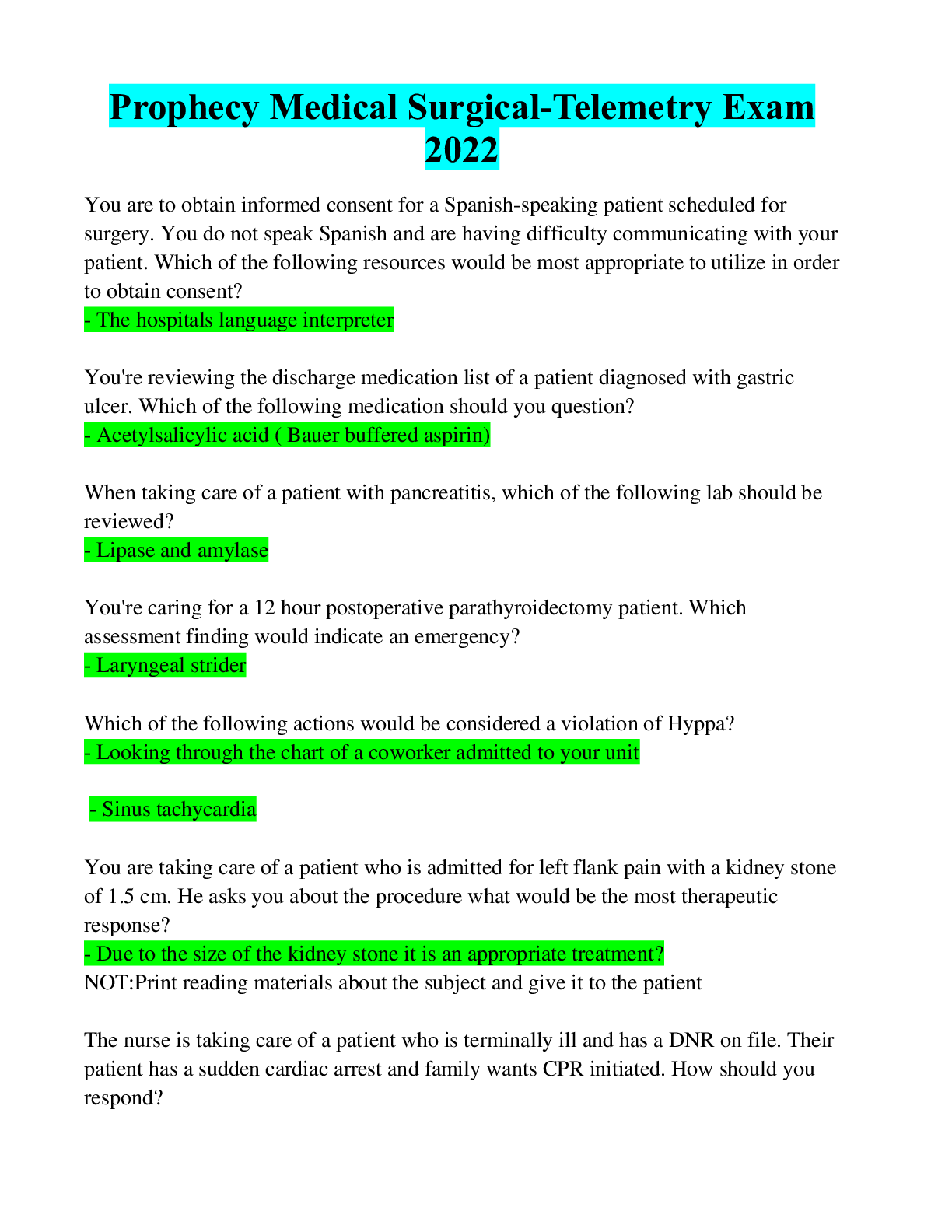
.png)
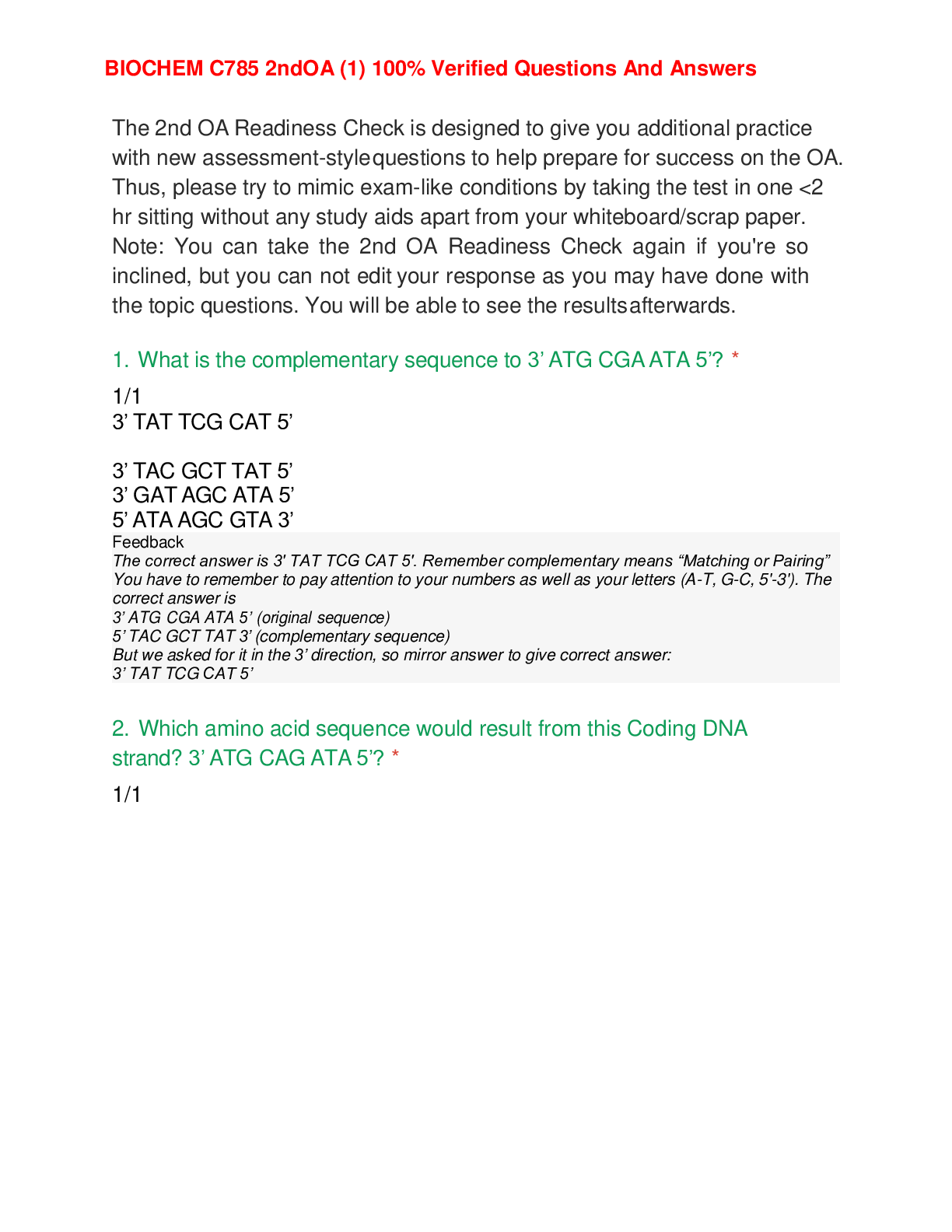
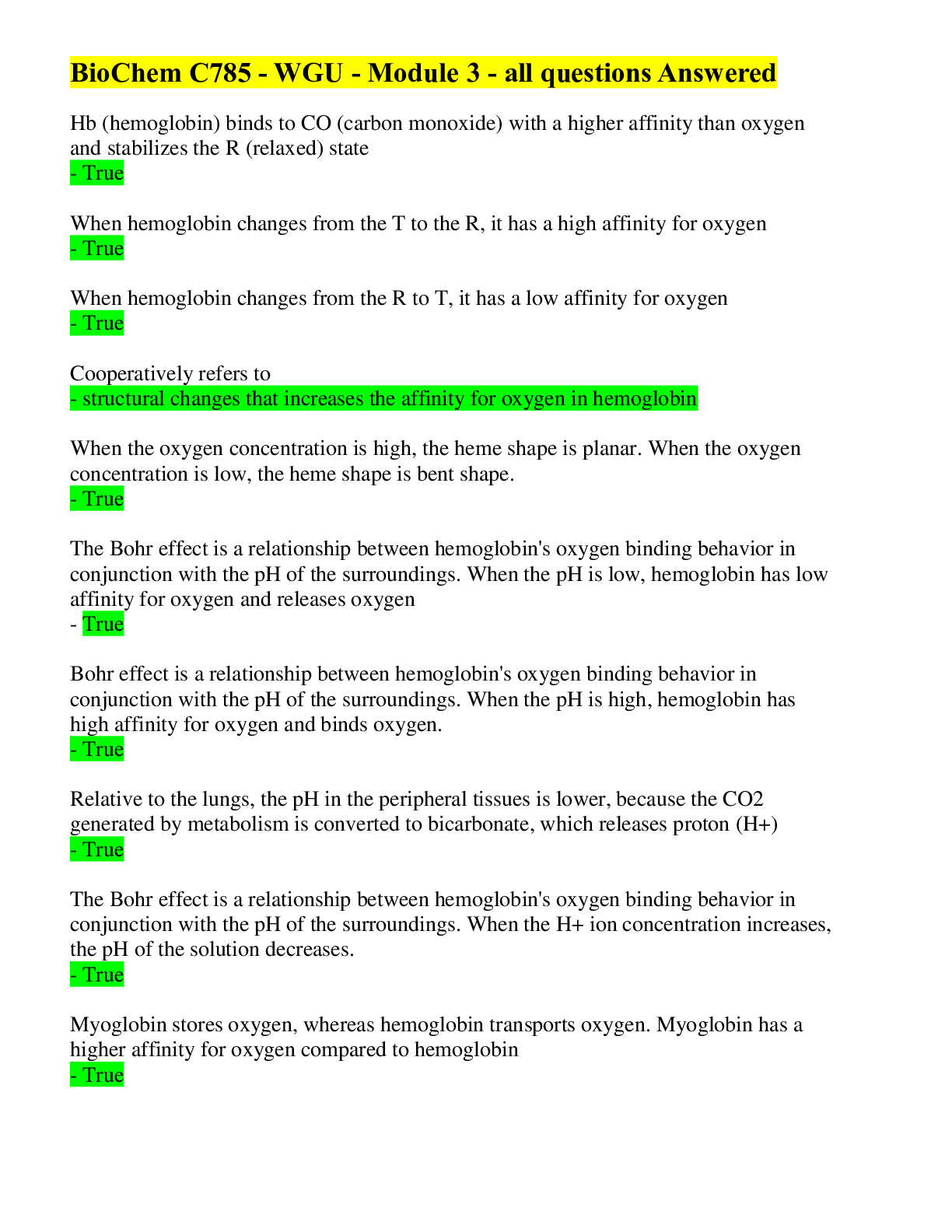
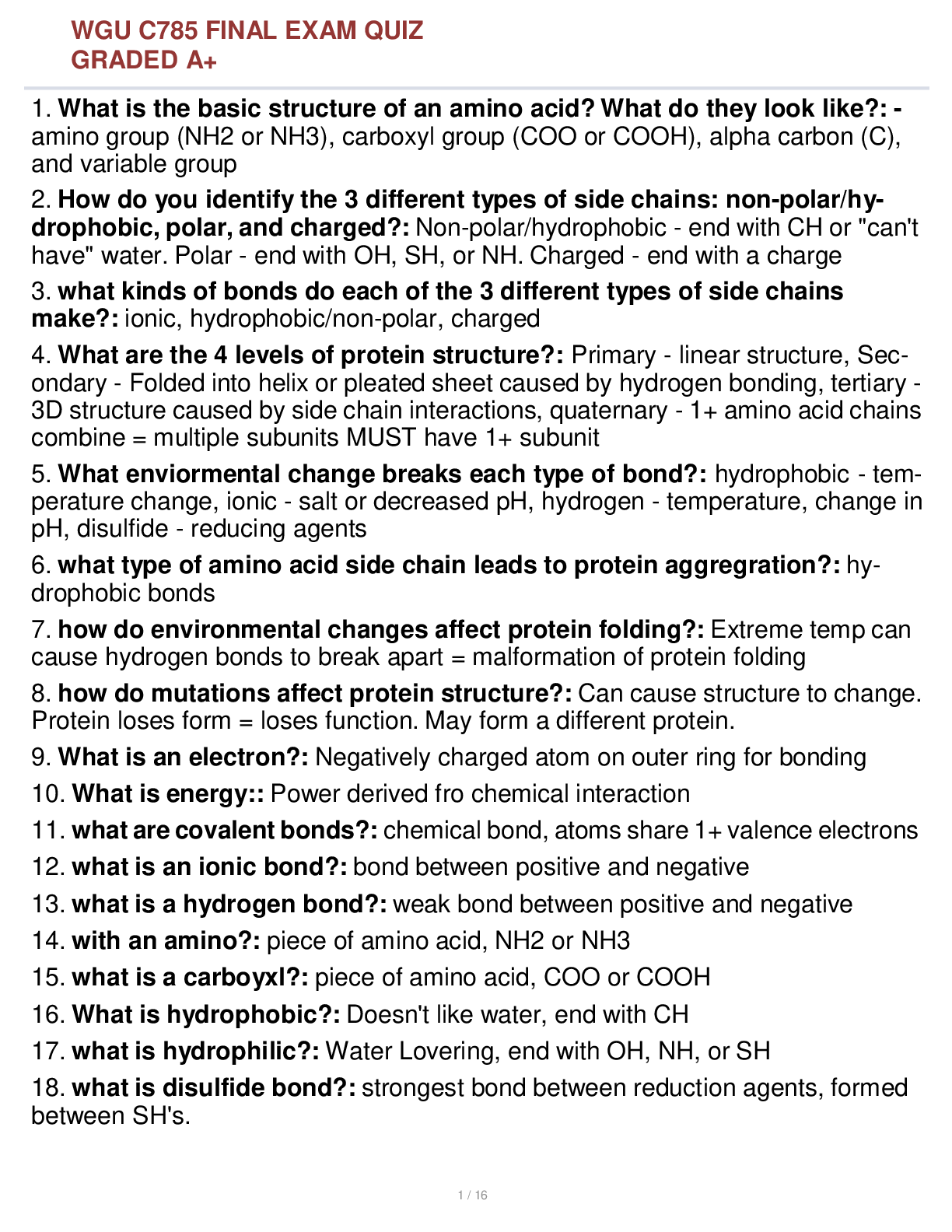
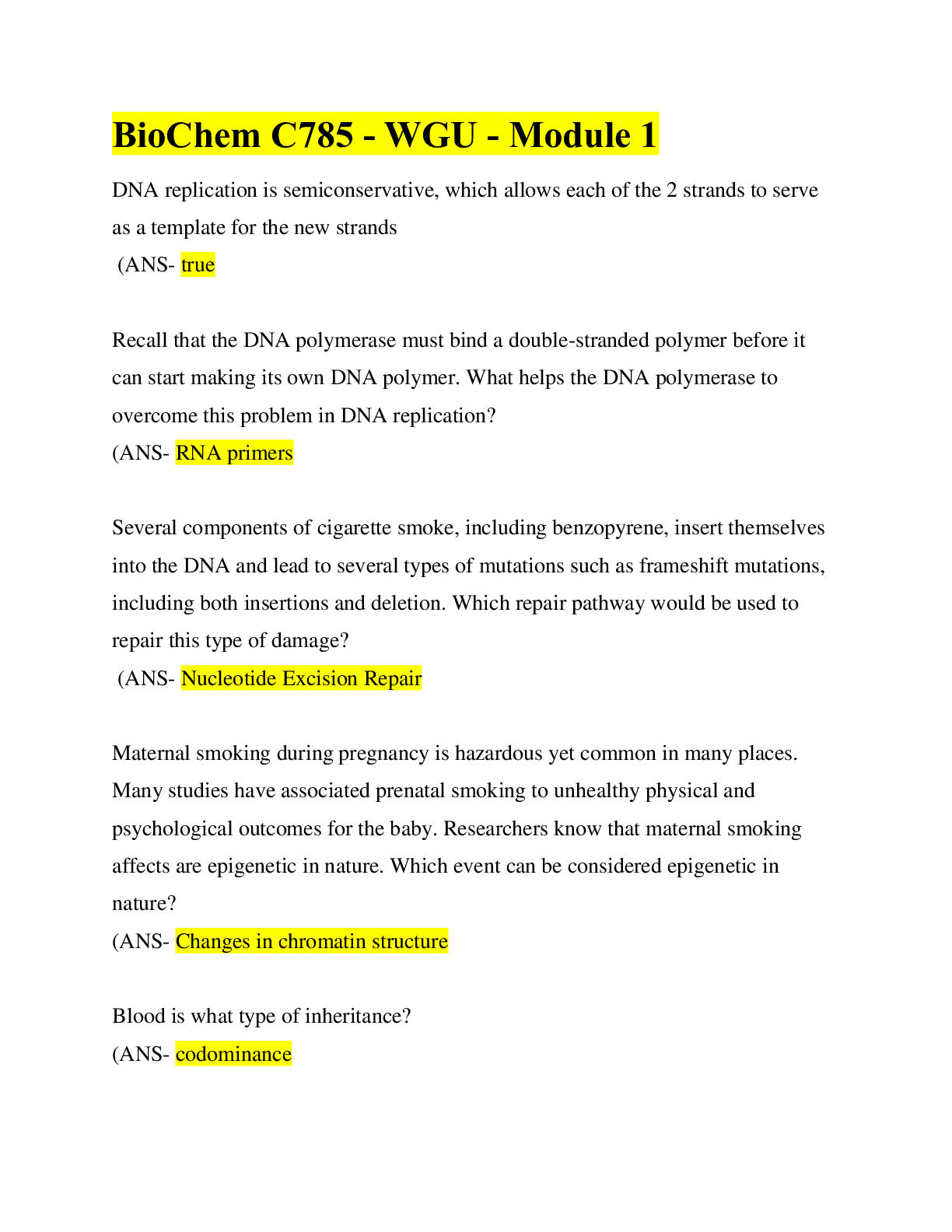
.png)



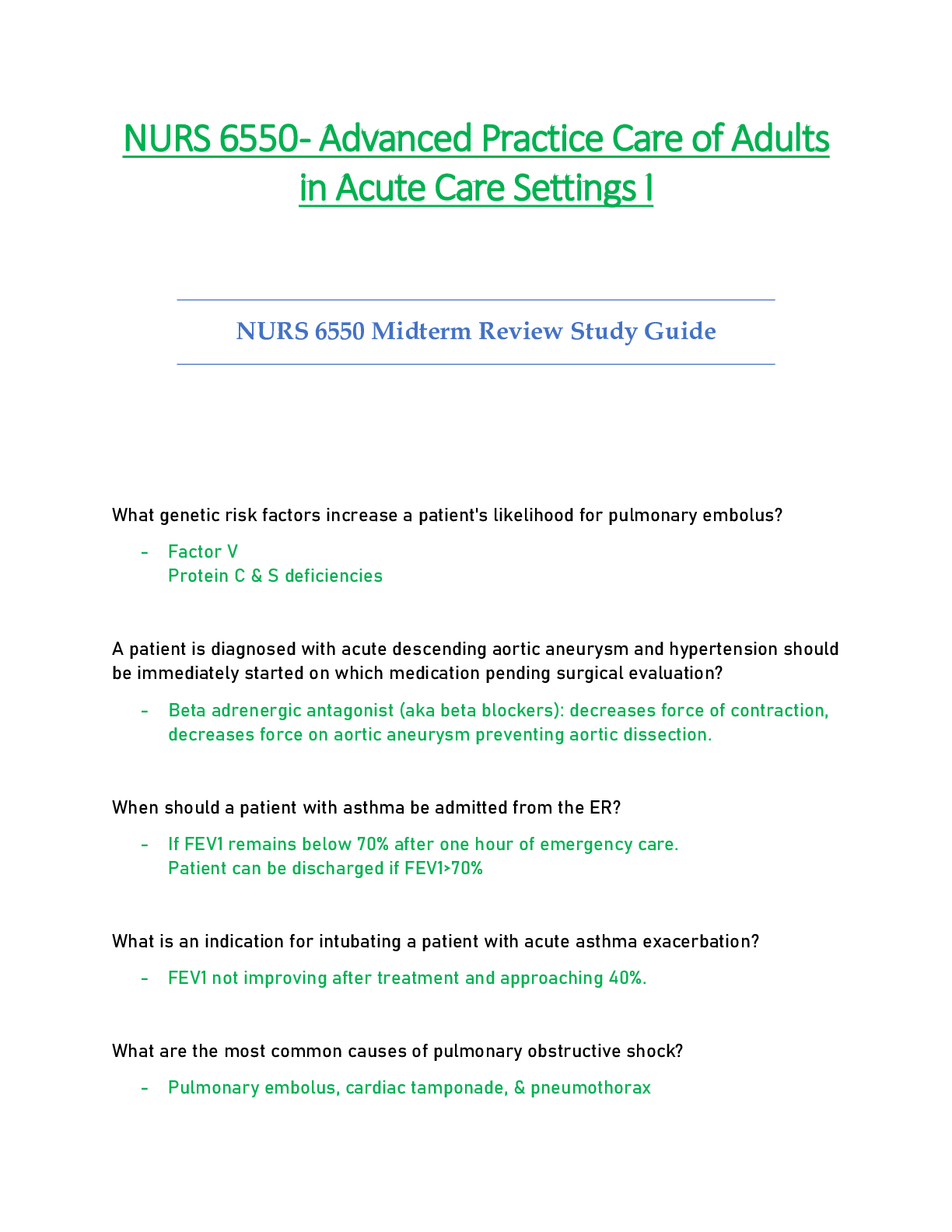

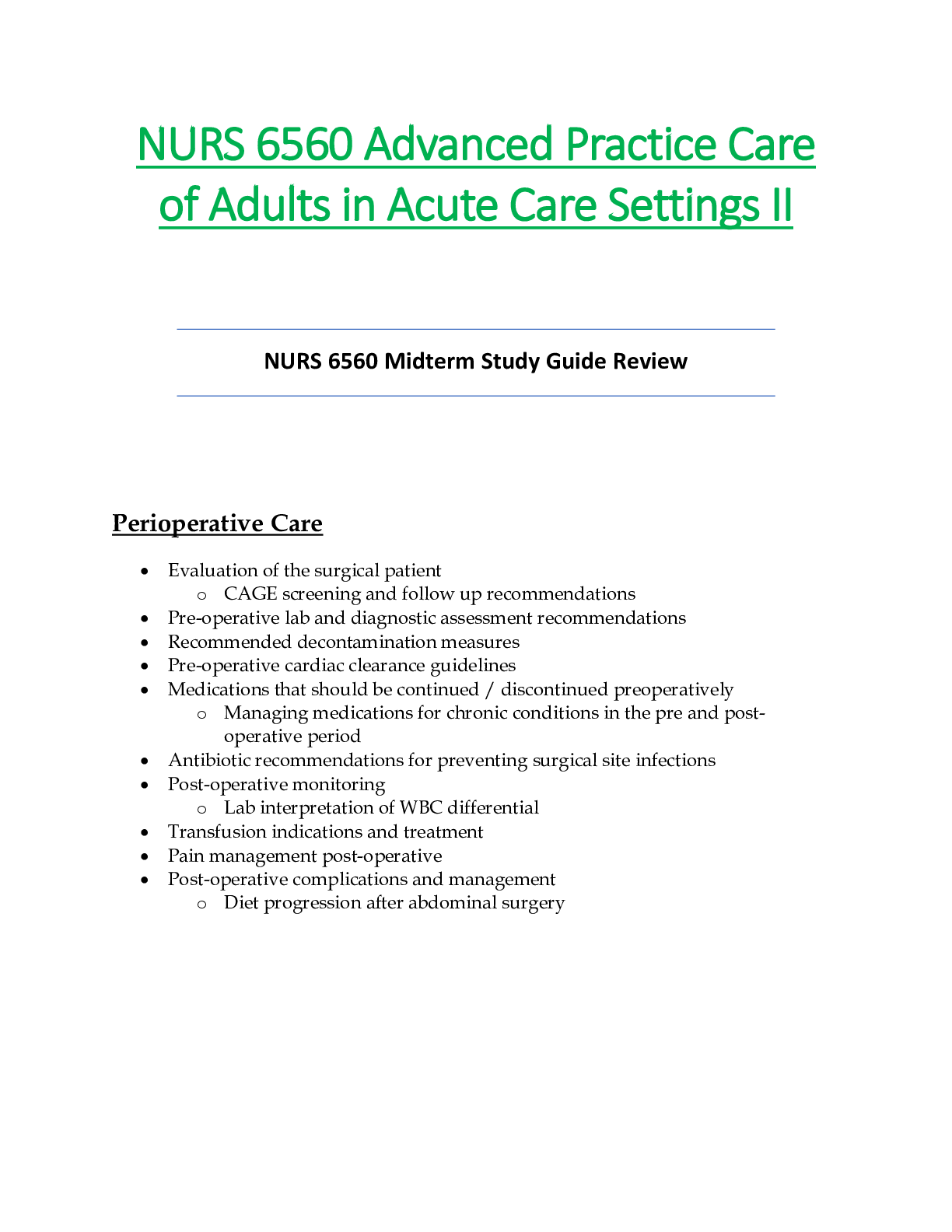


 MY21.png)

 MY21.png)


